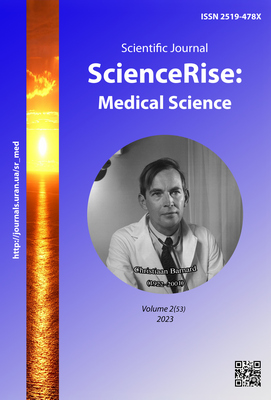Secondary sinusogenic neuritis and optic nerve atrophy
DOI:
https://doi.org/10.15587/2519-4798.2023.278978Keywords:
optic neuritis, optic nerve atrophy, OCT, RNFLAbstract
Cases of sinusogenic damage to the optic nerve are difficult to statistically process due to the variety of manifestations in the initial period and differences in the course, which does not make it possible to make a timely diagnosis, as well as standardize treatment. All this leads to the development of irreversible damage to the optic nerve, and therefore is relevant for study.
The aim of the study was to investigate signs of optic nerve atrophy caused by secondary neuritis combined with sinusitis using optical coherence tomography (OCT).
Research methods. 8 patients (16 eyes) aged 18-32 were examined at the Ivano-Frankivsk National Medical University with progressive optic nerve atrophy caused by secondary neuritis combined with sinusitis. The visometry, ophthalmoscopy, computer perimetry and OCT were used.
Result. Eight patients with optic nerve atrophy caused by secondary neuritis combined with sinusitis examined by OCT. The optic nerve damage in the early period (up to half a year) characterized by the appearance retinal neural fibers layer (RNFL)’s white sectors combined with red-yellow sectors on the side of the lesion. It could be evidence of edematous -degenerative processes.
Later, after more than a year, RNFL’s yellow-red sectors appeared on the side of the lesion and white on the opposite side. The finding characterizes the development of atrophy of the optic nerve and involvement of the opposite side.
Conclusion. To improve the diagnosis of optic nerve atrophy caused by secondary neuritis combined with sinusitis, the use of OCT parameters will help to obtain a more complete picture of the condition of the optic nerve and determine the optimal treatment plan
References
- Gallagher, D., Quigley, C., Lyons, C., McElnea, E., Fulcher, T. (2018). Optic Neuropathy and Sinus Disease. Journal of Medical Cases, 9 (1), 11–15. doi: https://doi.org/10.14740/jmc2926w
- Moiseienko, N. (2022). Nevryt zorovoho nerva chy zapalna optychna neiropatiia? (ohliad literatury). Oftalmolohichnyi zhurnal, 6, 44–49.
- Balcer, L. J., Prasad, S.; Daroff, R. B,, Fenichel, G. M., Jancovic, J., Mazziotta, J. C. (Eds.) (2012). Abnormalities of optic nerve and retina. Neurology in Clinical Practice. Philadelphia: Elsevier Saunders, 170–185. doi: https://doi.org/10.1016/b978-1-4377-0434-1.00015-3
- Hwang, S. H., Kim, Y. H., Shin, S. Y. et al. (2015). Relationship between chronic rhinosinusitis and optic neuropathy: A population-based study. American Journal of Rhinology & Allergy, 29 (1), e17–e21.
- Moyseyenko, N. (2021). Optical coherent tomography in the diagnosis of inflammatory and ischemic optical neuropathies (clinical cases). ScienceRise: Medical Science, 4 (43), 35–40. doi: https://doi.org/10.15587/2519-4798.2021.237821
- Abdulhamid, M. T. (2019). Optic nerve atrophy associated with paranasal sinusitis. Saudi Journal of Ophthalmology, 33 (4), 392–394.
- Lee, M. J., Jee, D., Suh, Y. J., Lee, J. K. (2015). Association between chronic rhinosinusitis and the risk of optic neuropathy: a population-based study. Journal of Neuro-Ophthalmology, 35 (3), 233–238.
- Friedman, D. I., Jacobson, D. M. (2012). The association between time to presentation and neuro-ophthalmic outcomes in patients with idiopathic intracranial hypertension. Journal of Neuro-Ophthalmology, 32 (4), 293–296.
- Del Noce, C., Marchi, F., Sollini, G., Iester, M. (2017). Swollen Optic Disc and Sinusitis. Case Reports in Ophthalmology, 8 (2), 421–424. doi: https://doi.org/10.1159/000476057
- Nien, C.-W., Lee, C.-Y., Wu, P.-H., Chen, H.-C., Chi, J. C.-Y., Sun, C.-C. et al. (2019). The development of optic neuropathy after chronic rhinosinusitis: A population-based cohort study. PLOS ONE, 14 (8), e0220286. doi: https://doi.org/10.1371/journal.pone.0220286
Downloads
Published
How to Cite
Issue
Section
License
Copyright (c) 2023 Nataliya Moyseyenko

This work is licensed under a Creative Commons Attribution 4.0 International License.
Our journal abides by the Creative Commons CC BY copyright rights and permissions for open access journals.
Authors, who are published in this journal, agree to the following conditions:
1. The authors reserve the right to authorship of the work and pass the first publication right of this work to the journal under the terms of a Creative Commons CC BY, which allows others to freely distribute the published research with the obligatory reference to the authors of the original work and the first publication of the work in this journal.
2. The authors have the right to conclude separate supplement agreements that relate to non-exclusive work distribution in the form in which it has been published by the journal (for example, to upload the work to the online storage of the journal or publish it as part of a monograph), provided that the reference to the first publication of the work in this journal is included.









